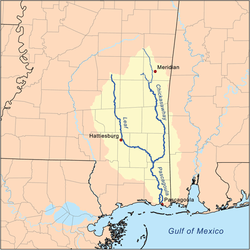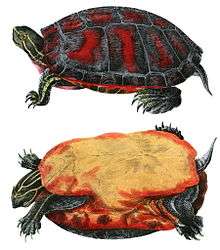Yellow-blotched map turtle
| Yellow-blotched map turtle | |
|---|---|
| | |
| Scientific classification | |
| Kingdom: | Animalia |
| Phylum: | Chordata |
| Subphylum: | Vertebrata |
| Class: | Reptilia |
| Order: | Testudines |
| Family: | Emydidae |
| Subfamily: | Deirochelyinae |
| Genus: | Graptemys |
| Species: | G. flavimaculata |
| Binomial name | |
| Graptemys flavimaculata Cagle, 1954 | |
| Synonyms | |
The yellow-blotched map turtle (Graptemys flavimaculata), or yellow-blotched sawback, is a species of turtle in the Emydidae family. It is part of the narrow-headed group of map turtles, and is endemic to the southern United States.
Conservation status
This species is listed as threatened under the US Endangered Species Act due to a recent decline. This can be attributed to a low reproductive frequency as compared with most other map turtles. A high level of nest mortality due to fish crow predation and river flooding are also attributed to endangerment. Unexpectedly high occurrences of nesting in shaded areas could possibly be attributed to human disturbances on and near sandbars, which raises mortality rates.[4]
Also, its habitat suffers from pollution and agricultural changes to water levels, affecting nesting beaches. "Turtle plinking", shooting turtles for casual target practice, kills significant portions of this endangered turtle's population each year.[5]
Geographic range

Its distribution is limited to the Pascagoula River of Mississippi and most of its tributaries (a range it shares with the Pascagoula map turtle).
Home range
Males have a mean home range area of 1.12 ha (2.77 acres) and a mean home range length of 1.8 km (1.1 mi). Females have a mean home range area of 5.75 ha (14.20 acres), due to nesting activities, and a mean home range length of 1.5 km (0.93 mi).[6]
Description
Yellow-blotched map turtles are medium- to small-sized turtles, with males ranging from 3.5 to 4.5 in (9-11.5 cm) in carapace length as adults. Adult females are larger, about 5 to 7.5 in (13–19 cm) in carapace length. The yellow-blotched map turtle has the highest central keel of all map turtles.
Diet
Yellow-blotched map turtles feed mostly on insects, but are opportunistic feeders, so also consume crustaceans, fish, and some fresh plant matter.
References
- ↑ van Dijk, P.P. (2010). "Graptemys flavimaculata". IUCN Red List of Threatened Species. Version 2011.1. International Union for Conservation of Nature. Retrieved 8 October 2011.
- ↑ Fritz, Uwe; Havaš, Peter (2007). "Checklist of Chelonians of the World". Vertebrate Zoology. 57 (2): 187. Archived from the original (PDF) on 2010-12-17. Retrieved 29 May 2012.
- ↑ Conant, R. 1975. A Field Guide to Reptiles and Amphibians of Eastern and Central North America, Second Edition. Houghton Mifflin. Boston. xviii + 429 pp. + 48 plates. ISBN 0-395-19977-8 (paperback). (Graptemys flavimaculata, p. 59 + Plate 8 + Map17.)
- ↑ Horne, B.D. et al. 2003. Reproductive and Nesting Ecology of the Yellow-blotched Map Turtle, Graptemys flavimaculata: Implications for Conservation and Management. Copeia 2003 (4): 729-738.
- ↑ Graptemys flavimaculata at The World's Top 25 Most Endangered Turtles 2003.
- ↑ Jones, R.L. 1996. Home range and seasonal movements of the turtle Graptemys flavimaculata. Journal of Herpetology 30 (3): 376-385.
External links
- Tortoise & Freshwater Turtle Specialist Group 1996. Graptemys flavimaculata. 2006 IUCN Red List of Threatened Species. Downloaded on 29 July 2007.
Further reading
- Cagle, F.R. 1954. Two New Species of the Genus Graptemys. Tulane Studies in Zoology 1 (11): 165-186.
- Smith, H.M., and E.D. Brodie, Jr. 1982. Reptiles of North America: A Guide to Field Identification. Golden Press. New York. 240 pp. ISBN 0-307-13666-3 (paperback). (Grapemys flavimaculata, pp. 52–53.)

